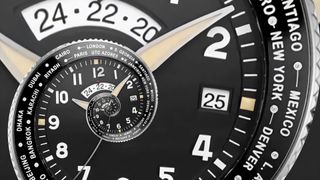
The measurement of a second is not as constant as you might think.
(Image credit: DigiPub via Getty Images)
There are 24 hours in a day, 60 minutes in an hour, and 60 seconds in a minute — so surely a second is just 1/(24 x 60 x 60), or 1/86400, of a day, right? Well, it turns out that defining time isn’t that simple.
We’re used to thinking of a second as a fixed increment of time, but this small unit has changed several times over the centuries.
“The second was originally based on the length of the day,” Peter Whibberley, a senior scientist at the National Physical Laboratory in the U.K., told Live Science. “People observed the sun passing overhead and started measuring its movement using sundials. Devices like that give a time based directly on the position of the sun in the sky, which is called apparent solar time.”
However, sundials have a few drawbacks. Aside from the obvious problem of not being able to read a sundial when the sun isn’t visible, relying on Earth’s daily rotation (also known as astronomical time) is surprisingly inaccurate.
“The rotation is not precisely constant,” Whibberley said. “The Earth speeds up and slows down over time. There’s a seasonal variation, big unpredictable variations from decade to decade due to changes in the molten core, and a longer-term slowing caused by the tides moving backwards and forwards.”
So how can we precisely measure time if using the length of a day is so unreliable?
Related: Where does the concept of time travel come from?
In the 16th century, people turned to technological solutions to this problem, and the first recognizable mechanical clocks began to emerge.
“The heart of making a clock basically moved from keeping time by following the position of the sun, to making an oscillator and defining a fixed number of oscillations to be equivalent to one second,” Sumit Sarkar, a physicist at the University of Amsterdam, told Live Science.
The earliest mechanical examples were pendulum clocks, which were designed to tick at a specific frequency, equivalent to an astronomical second, averaged over the course of a year. Over the next several hundred years, scientists worked on building better, more precise oscillators and developed myriad other timekeeping systems, including springs and gears.
By around 1940, quartz crystal clocks had become the new gold standard. “If you apply a voltage to a carefully shaped piece of quartz, it starts vibrating and you can tune the frequency of that oscillation very precisely,” Sarkar said. “But while this precision is fine for general use, it’s just not good enough for really technical applications, like the internet, GPS systems or studying fundamental research.”
Problems arise because every piece of quartz is unique and resonates slightly differently depending on physical conditions such as temperature and pressure. To be truly accurate, clocks need to be set against some independent, unchanging reference. This is where atomic clocks come in.
“Atoms have natural fixed resonances. They exist only in particular energy states and can only change from one state to another by absorbing or emitting a fixed amount of energy,” Whibberley explained. “That energy corresponds to a precise frequency, so you can use that frequency as a reference for time keeping.”
The first practical atomic clock, unveiled in 1955, measured the number of these microwave-induced energy transitions in cesium atoms during a single astronomical second. In 1967, the global scientific community agreed to redefine the second according to this number, and the International System of Units and Measurements now defines a second as the duration of 9,192,631,770 energy oscillations in a cesium atom.
Since then, the astronomical second has continued to vary, while the atomic second has remained at precisely 9,192,631,770 oscillations. These variations in astronomical time actually mean that, every few years, scientists must add a leap second to allow Earth’s slowing rotation to keep up with atomic time. This leap second is being abolished in 2035, but scientists and government agencies haven’t yet figured out how to handle this tiny discrepancy, Whibberley said.
But scientists are not content to rest with this definition, which is accurate to 10^-15s or one-quadrillionth of a second. Across the world, research teams are working on even more precise optical atomic clocks, which use higher-energy visible light-induced atomic transitions in elements such as strontium and ytterbium to improve this accuracy more than 100-fold. In fact, scientists are discussing whether it’s time to redefine the second again according to optical clock oscillations, using UV and visible light sources in place of microwaves.
But while several important questions still need to be answered before this happens, it’s clear that the precise definition of a second is subject to change.
Stay up to date on the latest science news by signing up for our Essentials newsletter.
Victoria Atkinson is a freelance science journalist, specializing in chemistry and its interface with the natural and human-made worlds. Currently based in York (UK), she formerly worked as a science content developer at the University of Oxford, and later as a member of the Chemistry World editorial team. Since becoming a freelancer, Victoria has expanded her focus to explore topics from across the sciences and has also worked with Chemistry Review, Neon Squid Publishing and the Open University, amongst others. She has a DPhil in organic chemistry from the University of Oxford.
>>> Read full article>>>
Copyright for syndicated content belongs to the linked Source : Live Science – https://www.livescience.com/physics-mathematics/mathematics/how-long-is-a-second































